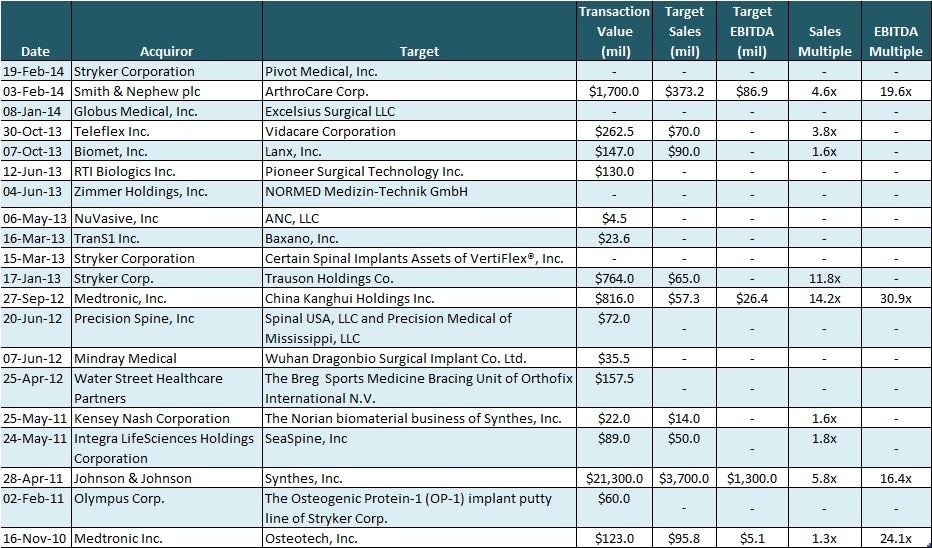Strategic Healthcare Mergers and Acquisitions (M&A)
2014 Spine Surgery Sector Trends
03/25/2014
As a backdrop to healthcare M&A actvitiy, leading dynamics in the spine surgery sector include:
- Minimally invasive Spine Surgeries (MISS)
increasingly being used to implant lumbar fusion devices, interspinous fusion systems, spinal non-fusion devices and to perform more simple procedures, such as discectomies. Traditional surgery requires a large incision in the back or abdomen, requiring the expertise of specialized vascular surgeons and risking serious injury. May involve surgical complications such as excessive blood loss and severe post-operative pain, and significant hospital stays and recovery periods.
- Lateral approach
More procedures are made with a lateral approach to the spine. Initial minimally invasive procedures approached the spine anteriorally or posteriorally, but there have been some proven benefits to the lateral approach when possible.
- Mobility Preservation
Motion-preservation techniques are gaining steam and have seen enhanced adoption rates over the last few years. Although, motion preservation has been a trend in orthopedics for years, spine surgeons are more recently seeking a middle path between fusion and artificial discs –balancing creating too much motion, which can be painful and destabilizing, with fusion, which restricts motion.
- Biologics and Disc Regeneration
New disc regeneration technologies using biologics and other synthetic fusion materials seek to promote the cushioning attributes of the spine. Allografts and autografts are being used in place of bone morphogenetic proteins (BMP) to stimulate bone and tissue growth.
- Intra-operative Visualization and Monitoring
The use of advanced fluoroscopy has improved the accuracy of incisions and implant placement, minimizing tissue trauma. Improved optics, cameras and lighting systems enable surgeons to visualize anatomic structures through small incisions with reduced radiation exposure and surgeon fatigue by eliminating or reducing dependence on a headlight.
- Robotics Assisted Spine Surgery
In January 2014, Globus Medical bought Excelsius Surgical for its robotic surgical system to navigate and facilitate minimally invasive surgical access, implant sizing, positioning and placement. Multiple studies of the competitive Mazor Renaissance have shown that it meaningfully increases the accuracy of implant placements in minimally invasive procedures. An issue with robotics systems is market adoption.
- New Advances in Intraoperative Neuromonitoring and Neurophysiology
Allow surgeons to perform procedures more accurately and safely, avoiding nerve and other collateral damage. Various neuromonitoring modalities including somatosensory evoked potentials (SSEP), transcranial electric motor evoked potentials (TCeMEP), spontaneous electromyography, and triggered electromyography serve as meaningful diagnostic tools to detect the sensitivity and specificity of potential impending neural injury.
- More spinal procedures being conducted in outpatient settings
As more surgeons are learning minimally invasive techniques and the technology develops for fusion procedures, more cases are held in the ambulatory surgery center setting. Anterior cervical discectomies and fusions are performed regularly in some ambulatory surgery center settings, and additional procedures could make the transition in the future.
- Improved Market Conditions
While payers are still pushing back on certain procedures, pricing is stabilizing. Overall, 2014 spine market expected to increase in low single digits.
- The Market is Shifting Away from Physician-owned Distributorships (PODs)
PODs offered lower costs to hospitals, but the Office of the Inspector General labeling them as "inherently suspect“ due to conflicts of interest. Large health care systems are reducing reliance on PODs and this may help smaller niche spine products manufacturers.
Recent healthcare M&A activity in the spine surgery sector follows:


